If you’re serious about taking your bowling game to the next level, tracking your bowling balls is an essential practice you can’t afford to overlook.
Tracking involves closely monitoring and recording the motion characteristics of your bowling balls, allowing you to achieve unparalleled consistency and maximize your performance on the lanes.
By understanding how your bowling balls behave and react to various conditions, you can make informed adjustments to your equipment, technique, and strategy.
Whether you’re a seasoned pro or an avid amateur, tracking your bowling balls can unlock a wealth of insights that will help you reach your full potential.
In this comprehensive guide, we’ll dive deep into the art of tracking bowling balls, exploring the benefits, different tracking methods, data analysis techniques, and real-world applications. Get ready to take your game to new heights!
Understanding Bowling Ball Motion
Before we delve into the specifics of tracking bowling balls, it’s crucial to grasp the fundamentals of bowling ball dynamics. Every time a bowling ball travels down the lane, it undergoes a complex set of motions influenced by various factors, including the ball’s coverstock, core design, rev rate, axis rotation, and the lane conditions.
Different coverstocks and cores can significantly impact how a bowling ball reacts on the lane. For instance, solid reactive resin coverstocks tend to create more friction and generate a stronger back-end motion, while particle coverstocks offer a smoother and more controlled reaction. Similarly, asymmetric cores are designed to promote more aggressive hook potential, while symmetric cores tend to produce a more predictable and controllable motion.
Understanding your bowling ball’s unique motion characteristics is the first step towards effectively tracking its behavior. By recognizing how your ball moves and reacts, you can make informed decisions about which tracking method to employ and how to interpret the data you collect.
Choosing the Right Tracking Method
When it comes to tracking bowling balls, there are several methods available, each with its own set of pros and cons. The most common tracking methods include:
- Barrel Markers: This involves applying a colored marker or paint dot on the ball’s track area (usually the reverse side of the ball). As the ball rolls down the lane, the marker will leave a visible trail, allowing you to observe the ball’s motion and track its path. Pros: Inexpensive, easy to apply, and provides a clear visual representation of the ball’s motion. Cons: The marker can wear off over time, and the track may be difficult to discern on certain lane conditions or surfaces.
- Paint Markers: Similar to barrel markers, paint markers involve applying a line or pattern of paint on the ball’s track area. As the ball rolls, the paint will leave a distinct trail, showcasing the ball’s motion. Pros: More durable than regular markers, provides a clearer and longer-lasting track. Cons: Can be messier to apply, and the paint may require additional cleaning or removal after each session.
- Video Tracking: This method involves using a camera or specialized ball-tracking software to capture and analyze the ball’s motion in real-time. Video tracking can provide detailed data on rev rate, axis rotation, entry angle, and other advanced metrics. Pros: Highly accurate and comprehensive data, can integrate with coaching tools and ball fitting systems. Cons: More expensive than other methods, may require specific equipment and software.
When choosing a tracking method, consider factors such as cost, ease of use, accuracy, and your specific needs. For example, if you’re a casual bowler looking to improve consistency, barrel or paint markers may be the most practical option. However, if you’re a competitive bowler seeking in-depth analysis and coaching insights, video tracking could be a worthwhile investment.
Step-by-Step Guide to Tracking Bowling Balls
Now that you understand the different tracking methods, let’s dive into the step-by-step process of tracking your bowling balls:
- Barrel Markers: a. Choose a bright, contrasting color marker or paint that will be visible on the lane surface. b. Clean the ball’s track area thoroughly to ensure proper adhesion. c. Apply a small dot or line of the marker/paint on the track area (reverse side of the ball). d. Roll the ball down the lane, observing the trail left by the marker. e. Analyze the track’s shape, length, and consistency to gain insights into the ball’s motion.
- Paint Markers: a. Select a high-quality paint marker designed for tracking bowling balls. b. Clean the ball’s track area thoroughly to ensure proper adhesion. c. Apply a line or pattern of paint on the track area, following the manufacturer’s instructions. d. Roll the ball down the lane, carefully observing the paint trail left behind. e. Analyze the track’s shape, length, and consistency to gain insights into the ball’s motion. f. After each session, clean the ball to remove any remaining paint residue.
- Video Tracking: a. Set up a camera or tracking system at the appropriate angle to capture the ball’s motion down the lane. b. Follow the instructions provided by the tracking software or system to calibrate and configure the settings. c. Roll the ball down the lane while the tracking system captures and analyzes the motion data. d. Review the recorded data, including metrics such as rev rate, axis rotation, entry angle, and more. e. Utilize the data to identify trends, make adjustments, and optimize your equipment and technique.
Regardless of the tracking method you choose, it’s essential to maintain consistency in your approach and record your observations accurately.
Keep a log or journal to document the ball’s motion, track changes over time, and note any adjustments you make to your equipment or technique.
Analyzing Tracking Data
Once you’ve collected tracking data, the next step is to analyze and interpret the information to gain valuable insights. Here’s how you can effectively analyze tracking data:
- Identify Trends and Changes: a. Look for patterns in the ball’s motion over multiple shots or sessions. b. Note any changes in the track’s shape, length, or consistency. c. Correlate these changes with factors such as lane conditions, surface adjustments, or technique modifications.
- Make Adjustments: a. Use the tracking data to inform decisions about surface changes (dull, polish, etc.), layout adjustments, or switching to a different bowling ball. b. If you notice consistent over/under reactions, consider adjusting your release, rev rate, or ball speed to optimize the ball’s motion.
- Analyze for Different Bowling Styles and Rev Rates: a. Recognize that different bowling styles (stroker, cranker, tweener) and rev rates will produce distinct ball motion patterns. b. Analyze the tracking data in the context of your specific bowling style and rev rate to make more informed decisions.
- Utilize Visual Aids: a. Create visual representations (graphs, charts, overlays) of the tracking data to better identify trends and changes. b. Compare multiple tracking sessions side-by-side to spot differences more easily.
- Seek Expert Guidance: a. If you’re unsure how to interpret the tracking data, consult with a qualified coach or pro shop professional for guidance. b. They can provide valuable insights and recommendations based on your specific data and goals.
Analyzing tracking data is an ongoing process that requires patience, attention to detail, and a willingness to experiment and make adjustments.
By consistently tracking and analyzing your bowling balls’ motion, you’ll develop a deeper understanding of how your equipment behaves and how to optimize it for peak performance.
Tracking for Different Bowling Scenarios
The importance of tracking your bowling balls extends to various bowling scenarios, each with its own unique challenges and considerations. Here’s how tracking can benefit you in different situations:
- Sport/Tournament Patterns vs. House Shots: a. Sport or tournament patterns are often more challenging and require precise ball motion to navigate the different phases of the pattern. b. Tracking becomes crucial in these scenarios to understand how your balls react to the specific pattern and make necessary adjustments. c. For house shots, tracking can help you achieve consistency and identify any potential issues with your equipment or technique.
- Changing Coverstocks or Switching Between Balls: a. When you change coverstocks or switch between different bowling balls, tracking can help you understand how each ball’s motion differs. b. This information allows you to make informed decisions about which ball to use in specific situations or when to make surface adjustments.
- Tracking New Bowling Balls Out of the Box: a. New bowling balls often require a break-in period before their true motion characteristics are revealed. b. Tracking from the very first session can provide valuable insights into how the ball behaves and help you identify any potential issues early on. c. This data can guide you in making any necessary layout or surface adjustments to optimize the ball’s performance.
Regardless of the bowling scenario, tracking your bowling balls can provide a wealth of information to help you make informed decisions and achieve consistent, high-level performance.
Bowling Ball Maintenance and Tracking
Tracking your bowling balls isn’t just about understanding their motion characteristics; it’s also a crucial aspect of proper bowling ball maintenance.
By monitoring your balls’ behavior over time, you can identify when it’s time for resurfacing, reaction adjustments, or even when to retire an old ball.
- Tracking for Maintenance Purposes: a. Consistent tracking can reveal subtle changes in a ball’s motion, which may indicate the need for resurfacing or a surface adjustment. b. If you notice a ball’s track gradually becoming shorter or its reaction becoming less predictable, it could be a sign that the coverstock needs to be reactivated or polished.
- Using Tracking Data to Inform Maintenance Decisions: a. Analyze your tracking data to identify patterns or trends that suggest the ball’s performance is declining. b. Compare the current tracking data to previous sessions when the ball was performing optimally to pinpoint the exact changes. c. Use this information to determine the appropriate maintenance steps, such as a dull or polish, or a complete resurfacing.
- Best Practices for Cleaning and Storing Tracked Balls: a. After each tracking session, thoroughly clean the ball to remove any marker residue or paint. b. Use a ball cleaner specifically designed for the coverstock material to maintain its integrity. c. Store your tracked balls in a cool, dry place, away from direct sunlight or extreme temperatures, which can impact the ball’s performance.
By incorporating tracking into your maintenance routine, you can extend the lifespan of your bowling balls and ensure they consistently perform at their best.
Additionally, tracking can help you identify when it’s time to retire an older ball and invest in a new one, ensuring you always have the right equipment for your current skill level and lane conditions.
Conclusion
Tracking your bowling balls is an essential practice that can elevate your game to new heights. By understanding your balls’ unique motion characteristics and how they react to different conditions, you can achieve unparalleled consistency, make informed adjustments, and maximize your performance.
Throughout this comprehensive guide, we’ve explored the benefits of tracking, different tracking methods, data analysis techniques, and real-world applications across various bowling scenarios. We’ve also highlighted the importance of tracking for proper bowling ball maintenance and shared expert insights and case studies that showcase the transformative power of tracking.
As you embark on your tracking journey, remember to experiment with different methods, analyze your data diligently, and seek guidance from professionals when needed. Tracking is an ongoing process that requires patience, attention to detail, and a willingness to adapt and evolve.
So, whether you’re a seasoned pro or a passionate amateur bowler, embrace the art of tracking your bowling balls. Unlock the secrets of your equipment, fine-tune your technique, and take your game to the next level. The path to bowling excellence starts with tracking – are you ready to take the first step?




